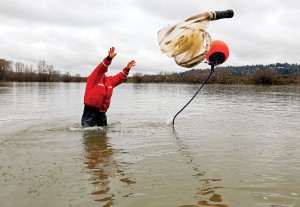The Daily News
 Dalton Fry cast a finely meshed net into the murky Cowlitz River. He waited a few minutes, then hauled it in and poured the contents into a glass jar. There swam dozens of smelt larvae, their eyes protruding from barely visible bodies. "There's probably 100 in there, no problem," Fry, who works for the Cowlitz Indian Tribe, said last week. Seals swimming nearby off the boat launch at Gerhart Gardens indicated that adult smelt were cruising the river, too... Read more >
Dalton Fry cast a finely meshed net into the murky Cowlitz River. He waited a few minutes, then hauled it in and poured the contents into a glass jar. There swam dozens of smelt larvae, their eyes protruding from barely visible bodies. "There's probably 100 in there, no problem," Fry, who works for the Cowlitz Indian Tribe, said last week. Seals swimming nearby off the boat launch at Gerhart Gardens indicated that adult smelt were cruising the river, too... Read more >











